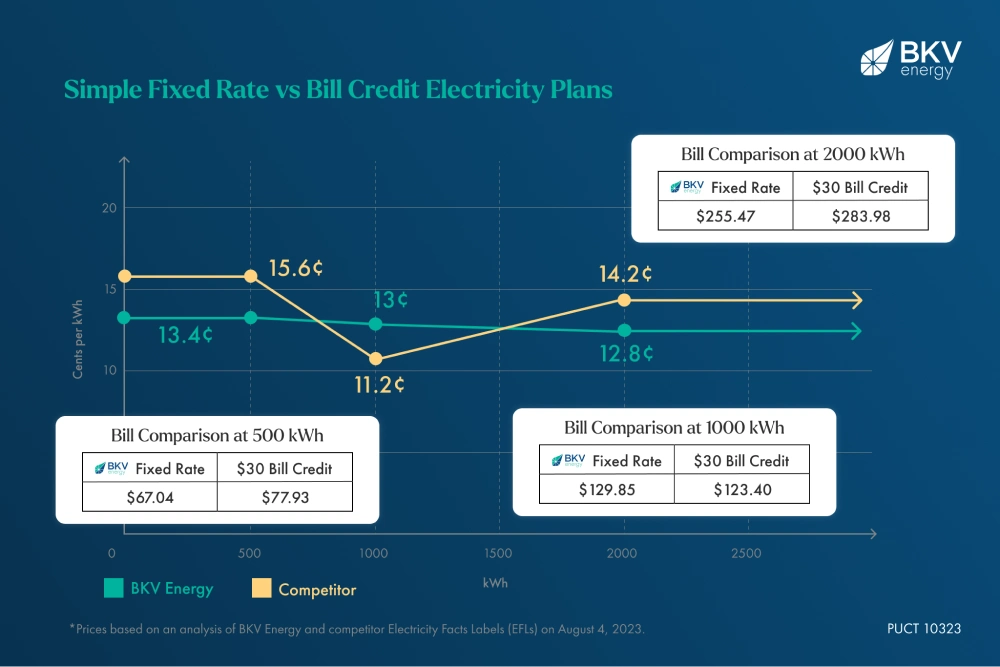What Electricity Company Services My Address
4 minute readFigure out what electricity companies service your home
Home > Learning Center > How the Energy Industry Works > How Bill Credit Electricity Plans Lead to Higher Monthly Payments
8 minute read • Last update January 2025

For most Texans, electricity plans with bill credits are not recommended. You are more likely to receive lower electricity bills when you opt for a simple fixed rate plan without a bill credit.
Every month, as you receive your electricity bill, you might wonder if there’s a way to save on those ever-increasing costs. One option that often catches the eye is enrolling in an electricity plan with a bill credit. But are bill credit electricity plans worth it?
Understanding the workings of a bill credit electricity plan and its potential impact on your monthly payments is key when considering this option.
Here’s how a bill credit plan works:
Choosing an electricity plan solely based on a bill credit might not be the best decision for everyone. Factors such as your monthly kWh usage, the rate per kWh, and potential tiered rate structure of the plan play a crucial role in determining whether you’ll save money. Comparing electricity prices per kWh with other plans, evaluating your historical kWh usage, and understanding the plan details is necessary for an informed decision before enrollment.

Bill credits are used as marketing tools by electricity providers to attract customers. If you use the right amount of energy, you get money back on your bill, but that does not mean you’ll end up spending less overall compared to another plan.
These plans are typically marketed as fixed-rate plans, ensuring that the rate you pay for electricity will remain constant, even with market fluctuations. However, the energy usage charge for a bill credit plan is comparatively higher than other plans. This means that if your usage falls above or below the specified range of the bill credit plan, you will be subject to a higher rate for electricity than anticipated. To avoid this, it’s important to monitor your usage closely.
Identifying the optimal usage and staying within that range is key to maximizing the benefits of a bill credit plan. Should your usage fail to meet the standards set in the bill credit plan EFL, there will be no bill credit applied. Understanding your electricity usage before choosing a plan is vital, as going beyond the upper limits of the bill credit plan can lead to much, much higher bills.
Bill credit plans can lead to increased bills, compared to a simple fixed rate plan, even with the application of bill credits. This is because the price per kWh for a bill credit plan is comparatively higher than other plans. You can find that the price per kWh for your electricity usage can be 5 to 10 cents higher with a bill credit plan. As a result, even with the application of the bill credit, your total cost of electricity may still be higher than anticipated.
The Electricity Facts Label (EFL) is an important document that provides essential information about an electricity plan, including rates, fees, and other associated details. Before enrolling in a bill credit plan, it’s crucial to review the EFL to understand the true costs and potential savings of the plan. This will help you avoid any surprises on your electricity bill, such as higher rates due to fluctuating usage or hidden fees. Here’s what to look for:
While bill credit plans might seem attractive initially, considering alternative electricity plans that match your needs and usage patterns is crucial. Two popular alternatives include fixed-rate plans and renewable electricity plans. Fixed-rate plans offer price stability and protection from market fluctuations, making them a popular choice for consumers.
On the other hand, renewable electricity plans are an eco-friendly option that can help reduce your carbon footprint. By exploring these alternative plan options and assessing your historical kWh usage, you can make an informed decision about the best electricity plan for your needs, taking into account the energy charge.
Remember, when looking for the right electricity plan, it’s important to consider the following factors:
Fixed-rate plans are electricity plans that offer a fixed rate for the duration of the contract, ensuring that the rate you pay for electricity will remain constant, even with market fluctuations. This price stability can be particularly beneficial for consumers who want to avoid unexpected changes in their monthly electricity bills.
However, it’s essential to note that some fixed-rate plans may include termination fees, which are charged by the provider when a fixed-rate electricity plan is cancelled prior to the expiration of the contract.
Reviewing the contract terms and conditions, along with the Electricity Facts Label (EFL), helps understand any potential fees and the contract duration while considering a fixed-rate plan. By doing so, you can ensure that you’re selecting a plan that meets your needs and provides the desired level of price stability.
Renewable electricity plans are another alternative to bill credit plans, offering electricity sourced from renewable energy sources such as solar, wind, and hydroelectric power. These plans can help reduce your carbon footprint while providing reliable electricity. In addition to the environmental benefits, renewable electricity plans can also contribute to the growth and development of the renewable energy sector, supporting the transition to a more sustainable energy future.
Reviewing the Electricity Facts Label (EFL) and understanding the renewable content of the plan, along with any associated fees or contract terms, is important when considering a renewable electricity plan. By doing so, you can ensure that you’re choosing a plan that aligns with your environmental values and provides reliable electricity at a competitive price.
While it is possible to save money with a bill credit plan compared to a simple fixed rate plan, those savings are difficult to achieve in Texas. The wide range of temperatures we experience across the state during the year lead to large variations in usage between cold and warm months, and extra high usage for most of the year thanks to our long and hot summers. If you carefully analyze your past kWh usage and thoroughly understand the plan’s terms, then you can determine whether a plan will help you find lower electricity bills.
Analyzing your historical kWh usage can help determine if a bill credit plan is suitable for your consumption patterns and if potential savings can be achieved. By reviewing your past electricity bills and comparing them to your current usage, you can identify any fluctuations in your electricity consumption and assess whether a bill credit plan is the most suitable option for you.
For example, let’s take the hypothetical example of a bill credit plan offers a $50 credit that applies when you consume between 1000 and 1500 kWh of electricity. If you look at your last 12 months of electricity usage and find that your electricity always fell between 1000 and 1500 kWh, then it’s possible this plan could be a good option for you.
Let’s take a look at another example of a hypothetical bill credit plan that offers a $30 credit when you consume more than 800 kWh of electricity. If you looked at your last 12 months of electricity consumption and found that your usage never exceeded 800 kWh, then you would not want to consider this plan. You’d never receive the credit on your bill.
It’s important to understand how your historical electricity usage impacts whether you’d receive a bill credit, but that’s not the whole story. You also need to compare the price per kWh between plans.
Determining whether you’d receive the bill credit at all is only half of the equation. You also need to factor in differing kWh rates at different levels of electricity consumption.
It is very common for bill credit plans to have a wide range of rates at different levels of usage. For example, we’ve found EFLs that list the following prices:
It’s the huge differences in prices per kWh when comparing bill credit plans and simple fixed rate plans that make the bill credit plans more expensive when you pay your monthly bill.

Weighing the pros and cons is important when considering a bill credit energy plan for an informed decision. The advantages of bill credits include the potential for savings for those with consistent usage patterns and the potential secure a lower electricity bill. However, the disadvantages of bill credits include the risk of higher bills due to varying usage, potential hidden fees, and the complexity of understanding the true costs of the plan.
By carefully evaluating the pros and cons of bill credit energy plans, you can determine if this type of plan is the right fit for your needs. Remember, the key to choosing the best electricity plan is understanding the true costs and potential savings, as well as considering factors such as bill credits, usage patterns, and alternative plan options.
Pros of bill credits include:
These benefits make bill credit plans an attractive option for some consumers.
However, it’s important to note that these potential savings are not guaranteed, and success largely depends on your ability to manage your electricity consumption within the specified range. If your usage falls outside of this range, you may not reap the full benefits of the bill credit, and your overall costs may be higher than anticipated.
Cons of bill credits include:
To avoid these potential pitfalls, it’s crucial to review the Electricity Facts Label (EFL) before enrolling in a plan and to assess your historical kWh usage. By doing so, you can ensure that you’re making an informed decision and avoid any surprises on your electricity bill.
By considering factors such as bill credits, usage patterns, and alternative plan options, you can ensure that you’re selecting the most suitable plan for your needs and potentially saving money on your monthly electricity bills. Reviewing the Electricity Facts Label, evaluating your historical kWh usage, and comparing electricity rates among different plans is crucial for the best possible decision.
While bill credit electricity plans may seem like an attractive option, it’s crucial to weigh the pros and cons and consider alternative plan options such as a simple fixed-rate plans. By doing so, you can make an informed decision and choose the best electricity plan for your needs.
Graham Lumley, Digital Marketing Manager at BKV Energy, leads digital and traditional marketing strategies, focusing on educating Texans about the state's deregulated energy market. With over 8 years of marketing experience, he creates content to help consumers understand and save on their energy bills, bringing a fresh and dynamic approach to the industry.

Figure out what electricity companies service your home

Are Free Nights and Weekends worth it? In this article we examine a couple of the most popular energy plans
Get $50 off your electric bill!
Use code BKVEJOINUS50
Enter your zip code to shop BKV Energy's affordable, fixed-rate Texas electricity plans. Use the promo code for $50 off your electric bill.